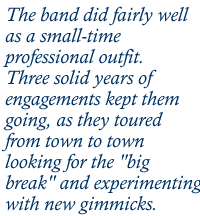|
Taking "Passion" on the RoadAfter
graduating from UNC in 1928, Kyser decided to take his act
on the road, with his band, his touring car called
"Passion," and Mack Riggsbee, who functioned as chef,
chauffeur, personal secretary, valet, chaperone and
friend. Before
the band headed out of town, Kyser asked Riggsbee to take
the car and get it checked, Riggsbee recalled in a 1983
Town and
Gown article. "I thought for
some unknown reason that he owned a Cadillac or Packard, but
it turned out to be a Model T Ford. The name
‘Passion’ was clearly written on both doors. There
was an anchor on the left side, which was thrown out to
‘keep Passion from running away with you’."
"To
their bewilderment when they arrived the next evening the
dance emporium was locked and deserted," the AP reported.
"After several hours they discovered the awful truth: The
applause the night before had been derisory, and the
proprietor’s return invitation his ultimate revenge for
his chagrin." Crushed, the band went to
Cleveland for five weeks, relying on Kyser’s friend
Riggsbee to cook for their survival. They returned to Chapel
Hill, where Kyser persuaded four professional musicians to
practice and play with them. Kyser’s band improved
steadily. The
band did fairly well as a small-time professional outfit.
Three solid years of engagements kept them going, as they
toured from town to town looking for the "big break" and
experimenting with new gimmicks. By 1932 they had exhausted
nearly every venue in the midwest and, desperate to survive,
trekked to California to play four weeks at the Bal Tabarin
in San Francisco. The whole band had less than $10 by the
time they crossed the Golden Gate Bridge.
During
the second stint at the Bal Tabarin, Kyser said, Martinelli
installed a trapeze from his club’s ceiling. "We
dressed (band member) Ish Kabibble in tights, turned-up
shoes and an over-sized bathrobe, and he sang ‘The Man
on the Flying Trapeze’ while sitting motionless on the
trapeze. It turned out to be the biggest hit of the show for
months and months," Kyser said. From
Bal Tabarin, the band was booked into the Blackhawk
Restaurant in Chicago, where — just as he’d
followed Hal Kemp’s footsteps at Chapel Hill —
Kyser’s band followed Kemp’s band, which was also
booked there. Jules Stein, head of MCA, signed Kyser’s
band there and assured them at least three months. At first,
the band drew very few customers in the restaurant, and
every week Stein had to persuade management to keep Kyser
signed. "That
was just about the time we hit on the idea of singing song
titles," Kyser recalled in Town and Gown. "The orchestra
would start each number with a short introduction followed
by a member of the band singing the title of the song. This
gave the band a special identity that it needed to head
really bigtime."
| |||
|
| |||
|
©1998 All Rights Reserved Feedback | Credits | |||


 Kyser credits Bal Tabarin owner Frank
Martinelli with keeping their hopes alive and starting them
on the path upward. He convinced Kyser to be the master of
ceremonies for the whole show and allowed the musicians to
wear their trademark white suits instead of more formal
tuxedos. The band’s audience grew. Kyser and company
moved to a Santa Monica club and returned to the Bal Tabarin
in autumn 1934. It was this second visit to
Martinelli’s club that would give the musicians the
break they’d been looking for.
Kyser credits Bal Tabarin owner Frank
Martinelli with keeping their hopes alive and starting them
on the path upward. He convinced Kyser to be the master of
ceremonies for the whole show and allowed the musicians to
wear their trademark white suits instead of more formal
tuxedos. The band’s audience grew. Kyser and company
moved to a Santa Monica club and returned to the Bal Tabarin
in autumn 1934. It was this second visit to
Martinelli’s club that would give the musicians the
break they’d been looking for.